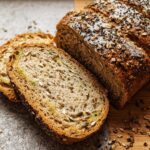Description
Learn what makes multigrain bread truly healthy, how it compares to other bread types, and how to select nutritious loaves. Discover how to identify high-quality multigrain bread and incorporate it into your diet for better health.
Ingredients
- Whole grains (e.g., whole wheat flour, oats, barley, rye)
- Water
- Yeast
- Salt
- Optional: Seeds (e.g., flax, sunflower, sesame), sweeteners (e.g., honey, molasses), fats (e.g., oil, butter)
Instructions
- Read bread labels carefully to understand the types of grains used.
- Prioritize breads that list whole grains as the first ingredient.
- Look for breads with a good source of fiber.
- Check for minimal added sugars.
- Identify breads with the Whole Grain Stamp.
- Compare multigrain bread to white bread and whole grain bread.
- Understand how to assess the healthfulness of your chosen multigrain bread.
- Consider how multigrain bread fits into weight management strategies.
- Evaluate if multigrain bread is suitable for individuals with diabetes.
Notes
- The term “multigrain” only indicates the presence of multiple grains, not necessarily that they are whole grains.
- Refined grains in multigrain bread offer fewer nutrients than whole grains.
- Always check the ingredient list and nutrition facts.
- Look for the Whole Grain Stamp for assurance of whole grain content.
- Prep Time: 15 minutes
- Cook Time: 30-40 minutes
- Category: Baking
- Method: Baking
- Cuisine: International
Nutrition
- Serving Size: 1 slice
- Calories: 80-120
- Sugar: 1-3g
- Sodium: 100-200mg
- Fat: 1-3g
- Saturated Fat: 0-1g
- Unsaturated Fat: 1-2g
- Trans Fat: 0g
- Carbohydrates: 15-25g
- Fiber: 2-4g
- Protein: 3-5g
- Cholesterol: 0mg
